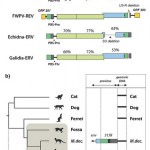In a phenomenon known as Peto's paradox, large mammals do not develop cancer more often than small mammals, despite having more cells that could go haywire. On Life Lines, Dr. Dolittle writes "Some researchers suggested that perhaps smaller animals developed more oxidative stress as a result of having higher metabolisms. Others proposed that perhaps larger animals have more genes that suppress tumors." But a new hypothesis argues that large mammals have evolved to minimize the activity of ERVs, which are ancient viral elements integrated into our DNA. Active ERVs can cause cancer and possibly…
body size
Since the first living things appeared on the planet, the biggest among them have become increasingly bigger. Over 3.6 billion years of evolution, life's maximum size has shot up by 16 orders of magnitude - about 10 quadrillion times - from single cells to the massive sequoias of today (below right). And no matter what people say, size does matter.
The largest of creatures, from the blue whale to the sauropod dinosaurs, are powerful captors of the imagination, but they are big draws for scientists too. Jonathan Payne from Stamford University is one of them, and together with a large team,…
